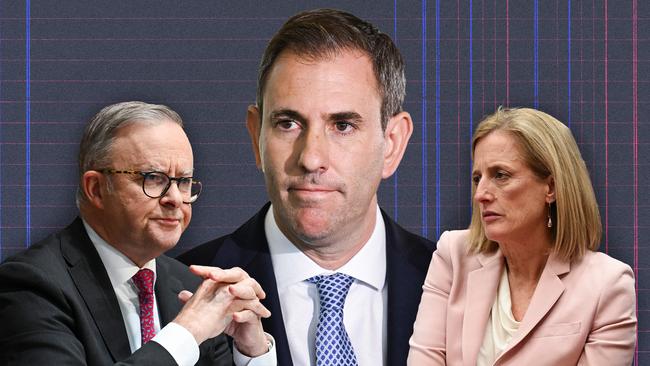
These politically volatile voters are not only paying for inflation through higher interest rates and higher household costs, they are also delivering the Treasurer his budget surplus aspirations through a significantly higher tax take.
There has been a significant upward revision on income tax revenue, which since the May budget amounts to an extra $30bn in personal income tax revenue for the government over the next four years. And that is after assuming the promised stage 3 tax cuts are passed.
More migrants, more jobs and lower unemployment may be at the heart of the forward projections but the story so far has been as much about bracket creep. The revision this year amounts to $9bn, only marginally less than the upgrades in tax take from corporate Australia.
And the Albanese government wonders why people are grumpy.
This is the double-edged political dilemma now facing Anthony Albanese and Chalmers. While most households are acutely aware of how much more they are paying for things, particularly their mortgages, they may be less aware of how much more tax they are paying now as well.
The mid-year update confirms what is already obvious to everybody else.
There are three primary groups of Australians wearing the economic problem and sharing the budget problem.
The first are wage earners, who are paying more for things.
The second are borrowers, who are paying more through higher interest rates.
And the third are taxpayers, who are paying more tax – the price of bracket creep.
While people on welfare are the most disadvantaged, they have been the target of the cost-of-living payment relief.
Middle Australia falls into all three categories, and it gets little if no assistance.
Economists will say that all this is a good thing. Sharing the pain is a necessary evil to get inflation down. Without it, the problem could be much worse and for longer. But managing the politics of this conundrum is now Chalmers’s great challenge.
While the budget position is improving, the position of households continues to deteriorate. Notable in the MYEFO forecasts is an emerging divergence between the Treasury and the central bank on the inflation problem.
Treasury is much more optimistic about the forecasts for inflation coming down. Considering neither the Reserve Bank nor the Treasury modellers saw the problem coming in the first place, predictions about when the country comes out of it are dubious.
Yet if we say Treasury is right, it is assuming that the inflation problem recedes to a point just in time for the stage 3 tax cuts to have an immaterial impact on inflation and hence the central bank’s partiality for bringing back out the interest rate hammer.
At least Chalmers can claim a significant improvement in the budget position.
Thanks to taxpayers, he is on track for a likely second surplus next year.
Having resisted more cost-of-living spending, the government has been able to bank most of the revenue gains on to the budget bottom line.
This is the responsible approach – to do otherwise would have only added to the inflation problem.
“This budget update is all about responsible economic management,” Chalmers says.
The caveat to all this is that the budget update is not quite as responsible as was being touted.
Overall, government spending has ticked back up. This is thanks to the states and territories that managed to squeeze more cash out of the Prime Minister last week for the NDIS, health and GST. Hence the structural position is in fact slightly worse than it was in May.
The politics don’t get any easier for Chalmers, with the government boasting to have more money when most of the community has less.
Chalmers knows that there is a long game here which the government hopes will eventually pay political dividends.
But considering that MYEFO forecasts and the fiscal settings are all about timing, if the timing is out, then it could easily all go pear-shaped.







If there is one thing Jim Chalmers’s mid-year budget update has confirmed, it is that middle Australia is now doing all the heavy lifting. On multiple fronts.